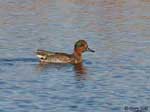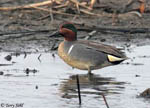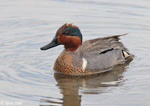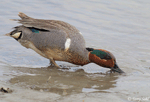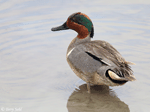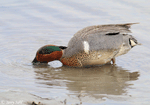Green-winged Teal
Anas crecca
| Length: 12 to 16 inches | Wingspan: 20 to 24 inches | Seasonality: Summer / Migrant |
|
ID Keys MALES: Rusty head with green patch extending behind eye, white bar on site of chest, yellow "tail-light" ID Keys FEMALES: Gray bill, small size, dark eyeline, plumage similar to many female dabbling ducks |
||
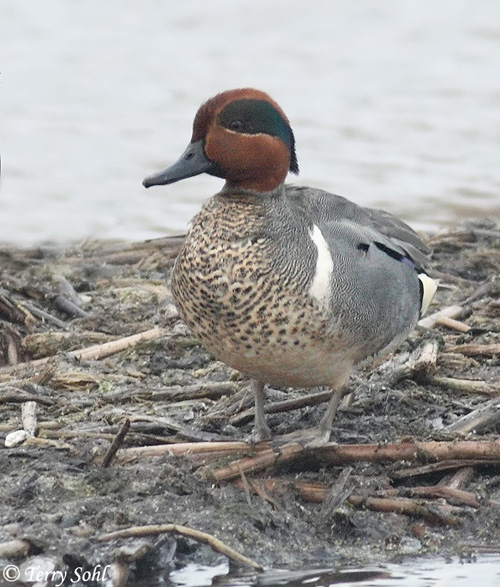 Green-winged
Teal are a common,
fast-flying dabbling duck, often forming tight compact flocks as they wheel and
turn in unison. Green-winged Teal tolerate cold weather better than other
teal, and can thus be found further north in the winter. They also tend to
arrive a bit earlier in the spring than some other ducks such as the
Blue-winged Teal. They are the smallest of the "dabbling ducks" found in the
United States. Males are rather distinctive if seen well, although the green
"swoosh" through the eye is similar to that of an
American Wigeon. Females are much more
difficult to identify as they are similar in plumage to other dabbling duck
females, although the small size helps differentiate them.
Green-winged
Teal are a common,
fast-flying dabbling duck, often forming tight compact flocks as they wheel and
turn in unison. Green-winged Teal tolerate cold weather better than other
teal, and can thus be found further north in the winter. They also tend to
arrive a bit earlier in the spring than some other ducks such as the
Blue-winged Teal. They are the smallest of the "dabbling ducks" found in the
United States. Males are rather distinctive if seen well, although the green
"swoosh" through the eye is similar to that of an
American Wigeon. Females are much more
difficult to identify as they are similar in plumage to other dabbling duck
females, although the small size helps differentiate them.
Habitat:
Marshes and shallow ponds and lakes in the breeding season. Found in similar habitats during winter and in migration, but can also be found in shallow coastal bays and estuaries.
Diet:
Primarily feeds on plant material, including seeds, grasses, and aquatic plants. Also will eat insects, crustaceans, and mollusks.
Behavior:
Usually travels in small flocks, although at major migration stopovers, flocks may number in the thousands. They rest out of the water more than many ducks, and can sometimes be found on low-hanging branches and logs. Foraging is primarily by upending in shallow water, filtering mud through the bill, and by picking items from the water's surface.
Nesting:
Late May and June in South Dakota. The nest of a Green-winged Teal is built on the ground, sometimes up to a few hundred yards away from any water, in a clump of dense vegetation or in a similarly protected location. The nest itself is a depression, lined with down and surrounded and filled with leaves, grasses, and other vegetative material. The female lays between 6 and 12 eggs, and she alone incubates them. The young hatch after about 3 weeks. Within a day after hatching, the young are mobile and forage for themselves, but the female will protect them.
Song:
Green-winged Teals males primarily have a whistling song and call, while the females have a quacking call.
1Click here to hear the whistling calls of a male Green-winged Teal, recorded in Snohomish County, Washington.
2Click here to hear the quack of a female Green-winged Teal, recorded in Yavapai County, Arizona.
Migration:
Summers throughout Canada, Alaska, and much of the northern and western United States. Winters in the southern half of the United States and points south, through Mexico and into Central America.
Interactive eBird Map:
Click here to access an interactive eBird map of Green-winged Teal sightings
Similar Species:
Males are generally easy to identify if seen well, while females are much more problematic. The following species are most likely to be confused with a Green-winged Teal:
- American Wigeon - The male Green-winged Teal and American Wigeon both share similar green "swoosh" through the eye and to the back of the neck. However, American Wigeons have a white stripe on their crown (hence the moniker "baldpate"), and lack the rusty coloring on the head of a Green-winged Teal. American Wigeons also lack the white vertical stripe on the front flanks of a Green-winged Teal, and have a warmer-toned body than the grayish tones of a male Green-winged Teal. Females of both species are somewhat similar, but the female American Wigeon has a two-toned, shorter bill, while a female Green-winged teal has a monotone dark bill.
- Blue-winged Teal - Males are easily distinguished, but females are very similar. The easiest way to differentiate is if the green speculum on the wing is showing on the Green-winged Teal. Otherwise, the female Green-winged Teal is generally paler, and is noticeably smaller if size can be accurately judged.
- Cinnamon Teal - Males are easily distinguished, but females are very similar. The Cinnamon Teal is a larger bird, and the bill is also noticeably larger than a Green-winged Teal.
Conservation Status:
Population trends are not well established, particularly at a regional level, although it's thought that overall populations are relatively stable. They are still common in many parts of their range, and are found over a very broad geographic area. The IUCN currently lists the Green-winged Teal as a species of "Least Concern".
Further Information:
1) USGS Patuxent Bird Identification InfoCenter, Green-winged Teal
2) Audubon Guide - Green-winged Teal
3) WhatBird - Green-winged Teal
Photo Information:
April 1st, 2012 - Dewey Gevik Nature Area near Sioux Falls, South Dakota - Terry Sohl
Additional Photos:
Click on the image chips or text links below for additional, higher-resolution Green-winged Teal photos.
Audio File Credits:
1Bruce Lagerquist, XC356905. Accessible at www.xeno-canto.org/356905
2Paul Marvin, XC452502. Accessible at www.xeno-canto.org/452502
| Click on the range map for a higher-resolution view |
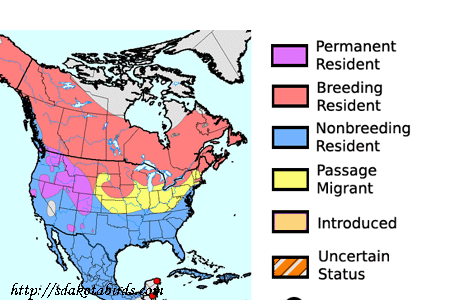 |
| South Dakota Status: Common migrant throughout South Dakota. Uncommon summer resident, most common in the northeastern part of the state. Rare in winter where open water exists. |
Additional Green-winged Teal Photos
Click for a higher-resolution version of these photos
